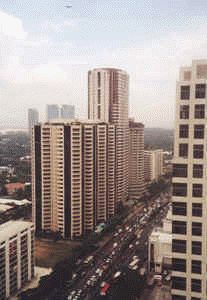Tribung
Pinoy
The
Philippines
Brief
History
Philippine
Government
The
Gateway
Economic
Profile
Arts
& Culture
Indigenous
People
Speak
Filipino
Music
& Song
Photo
Gallery
Important
Links
What's New?
Links to Philippine media
organizations, embassies & consulates,
public and private offices and organizations.
Click here
Philippine Flag
Click here
National Anthem
Click here
|
Trade,
Industry and Economy
The Philippines is blessed with an abundance of rich, productive
soil and tropical climate in which many plants grow quickly and well.

Makati Business Center |
Agriculture is the principal industry. Its agricultural sector is
the backbone of the economy, employing 10.16 million of the country's labor force,
generating 23.2 percent of the gross domestic product and contributing significantly to
the nation's total exports. Products include rice, sugar, abaci, coconut, banana, corn,
fruits and vegetables. Other crops in the billion peso (i.e., the value of their output
exceeded the billion peso mark) are coffee, mangoes, tobacco and rubber.
Although the United
States has long been its major
trading partner, the Philippines is at present actively establishing trade relations with other
countries.
Investing in the Philippines gives you a distinct advantage. In
this era of stiff global competition, getting ahead means cutting down on costs, obtaining
superior service, and earning good returns. The Philippines gives you this edge. These are
the operative factors:
1. Strategic location. The Philippine archipelago is located at
the southern rim of the Asia mainland. It lies at the crossroads of eastern and western
business, trade and culture.
2. Highly
educated professionals and workers. Filipinos are among the best educated and most easily
trainable people in Asia. They are universally conversant in English and are capable of
performing the simplest to the most complicated tasks with ease.
3. A democratic government. The country's leaders are committed
to free enterprise and are highly receptive to foreign participation in the country's
development.
4. Growing markets. This land of over 70 million people is a
large and demanding local market. The export market - practically the rest of the world -
remains insufficiently served. Both offer vast opportunities for your productive
undertakings.
5. Rich natural resources. Still vast and not fully exploited,
the country's wealth is being carefully managed.
6. Liberal policies and procedures. Business regulations are are
among the most flexible and receptive to the entry of foreign investments. The Philippines
allows 100% foreign ownership of many enterprises and assures full repatriation of
earnings and capital.
7. Expanding infrastructure. Programs to rapidly expand
transportation, communication, and other support facilities are underway.
8. World-class living conditions. You can obtain the best living
areas, business facilities, leisure and recreational amenities, and other requirements, at
the most reasonable costs.
Philippine economy ranks as world's 31st most competitive
The Philippine economy ranks as the world's 31st most competitive
among a list of 46 led by United States, according to a Swiss management school in their
report on world competitiveness.
In the World Competitiveness Yearbook presented, Lausanne
International Institute for Management Development listed the Philippines behind Spain and
Thailand but ahead of Argentina and Colombia.
Of the 14 Asian countries in the list, the Philippines only came
ahead of India (38), Greece (40), Indonesia (41).
Three other Asian countries -- Singapore, Hong Kong and Japan --
took the second, third and fourth, respectively behind the United States.
The Russian economy was the last in the list, following South
Africa and Vanezuela.
The rest of the countries in the top 20 are Denmark, Norway,
Holand, Luxembourg, Switzerland, Germany, New Zealand, Canada, Chile, Sweden, Finland,
Austria, Belgium, Taiwan and Great Britain and France.
Australia, Ireland, Malaysia, Israel, China, Korea, Italy, Spain
and Thailand complete the list of countries which have economies more competitive than the
Philippine economy.
Bringing up the rear are Argentina, Colombia, the Czech Republic,
Turkey, Portugal, Brazil, India, Hungary, Greece, Indonesia, Mexico, Poland, South Africa,
Venezuela and Russia.
Historical background
The Philippines had some commercial relations with neighboring
countries of the Far East long before contact with West was established. Goods from
Southeast Asia and Western world were carried by Arabs traders to the Philippines through
northern route, while Chinese goods, such as glass beads and porcelain dishes, found their
way into the Philippines through the southern route. Philippine goods were brought to
the Chinese mainland through the port of Canton by Arab ships.
By the middles of the 14th century, other countries of the Far
East had begun to take an active interest in Philippine trade. Cambodia and Champ in
Indo-China, traded their porcelain products with Philippine wares. A little later, Annam,
Siam and Tonkin also began to trade with the Philippines.
In the 15th century, upon the establishment of the Malaccan
Empire, Islam began to spread to the southern Philippines. Indo-China trade diminished and
the Chinese traders pressed back by the Muslims, sought new rading routes to those parts
of the Philippines where Islam had not yet gained a foothold. Later on, however, the
Chinese were allowed to trade with the areas under the sway of Islam.
When the Spaniards came to Luzon in 1570, they found Mohammedan
Filipinos actively engaged in commercial intercourse with Chinese and Indo-Chinese
traders.
|